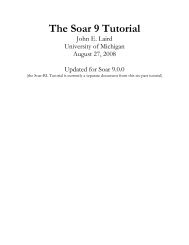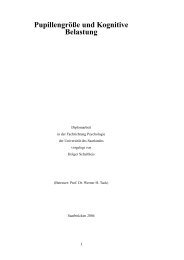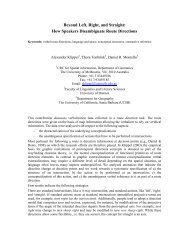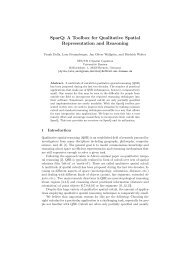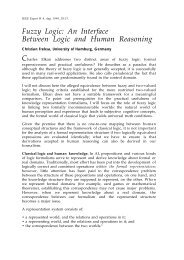Schematic Maps for Robot Navigation - the Cognitive Systems Group
Schematic Maps for Robot Navigation - the Cognitive Systems Group
Schematic Maps for Robot Navigation - the Cognitive Systems Group
You also want an ePaper? Increase the reach of your titles
YUMPU automatically turns print PDFs into web optimized ePapers that Google loves.
<strong>Schematic</strong> maps are well suited to represent qualitative spatial concepts. The<br />
orientation of a line on <strong>the</strong> map may correspond to a general orientation (or category<br />
of orientations) in <strong>the</strong> nature; a distance on <strong>the</strong> map may correspond to <strong>the</strong> number of<br />
train stops, ra<strong>the</strong>r than to <strong>the</strong> metric distance in nature, etc. (Berendt et al., 1998).<br />
If we consider abstract mental concepts of <strong>the</strong> spatial world as constituting one<br />
extreme in a hypo<strong>the</strong>tical continuum of representations and <strong>the</strong> concrete physical<br />
reality itself as <strong>the</strong> o<strong>the</strong>r extreme, it is interesting to determine where different types<br />
of representations of <strong>the</strong> world would be located in this continuum. Mental concepts<br />
can be manifested most easily by verbal descriptions (in fact, some researchers<br />
believe that we cannot think what we cannot express in words - Whorfian hypo<strong>the</strong>sis,<br />
Whorf, 1956). When we move in <strong>the</strong> hypo<strong>the</strong>tical continuum closer to <strong>the</strong> physical<br />
manifestation of <strong>the</strong> world, we can put concepts of spatial objects and relations into a<br />
sketch map to convey selected spatial relations. Sketch maps tend to have close<br />
correspondences to verbal descriptions and <strong>the</strong>y are used to augment verbal<br />
descriptions by spatial configurations that correspond to spatial configurations in <strong>the</strong><br />
physical world.<br />
Moving from <strong>the</strong> o<strong>the</strong>r extreme, <strong>the</strong> physical reality, we obtain a mild abstraction<br />
by taking a visual image (e.g. a photograph) that preserves important spatial relations.<br />
Moving a few steps fur<strong>the</strong>r towards concept <strong>for</strong>mation, we may get a topographic<br />
map in which objects have been identified and spatial relations from <strong>the</strong> real<br />
environment are maintained. Fur<strong>the</strong>r abstraction may lead to a schematic map as<br />
suggested above. Figure 2 depicts this abstraction scheme.<br />
abstract mental concepts<br />
verbal description<br />
sketch map<br />
schematic map<br />
topographic map<br />
photograph<br />
spatial environment<br />
Fig. 2. Abstraction levels between conceptual-linguistic and physical-spatial structures<br />
In this framework, schematic maps differ from sketch maps in that <strong>the</strong>y are derived<br />
from topographic maps that are meant to represent a certain part of <strong>the</strong> environment<br />
completely at a given granularity level. Sketch maps, on <strong>the</strong> o<strong>the</strong>r hand, usually<br />
correspond to <strong>the</strong> linear flow of speaking and drawing and frequently to <strong>the</strong> temporal<br />
sequence of route traversal (Habel & Tappe, 1999). Thus, schematic maps provide<br />
in<strong>for</strong>mation about a region while sketch maps more typically provide in<strong>for</strong>mation



